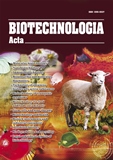ISSN 2410-7751 (Print)
ISSN 2410-776X (Online)

Biotechnologia Acta Т. 16, No. 3, 2023
P. 45-50, Bibliography 15, Engl.
UDC: 582.31.99:574.1:57.085.2:615.322
DOI: https://doi.org/10.15407/biotech16.03.045
Full text: (PDF, in English)
In vitro DIRECT SHOOT REGENERATION FROM Rhodiola rosea L. LEAF EXPLANTS
Matvieieva N., Belokurova V., Ratushniak Y., Shcherbak N.*, Kuchuk M.
Institute of Cell Biology and Genetic Engineering of the National Academy of Sciences of Ukraine, Kyiv
Wild plant species are of great interest as a source of pharmacologically valuable compounds but a significant number of them are endemic and/or endangered ones. Modern plant biotechnology can provide reliable methods for their utilization without disturbing natural populations. In vitro culture methods for Rhodiola species are being intensively developed to include them in various biotechnological programs.
Aim. Development of a protocol for direct Rhodiola rosea L. plant regeneration from leaf explants.
Methods. The leaves of R. rosea aseptically growing plants were used as the explants. Several variants of Murashige and Skoog (1962) agar-solidified culture medium supplemented with different combinations of auxins (α-naphthaleneacetic acid (NAA) and 2,4-dichlorophenoxyacetic acid (2,4-D)) and cytokinins (kinetin and 6-benzylaminopurine (BAP)) were estimated as potential regeneration-inducing media. Regeneration frequency was calculated as the percentage of leaves that produced shoots.
Results. The use of MS medium supplemented with 2.5 mg/l BAP and 1.0 mg/l 2,4-D allowed inducing shoot formation with 100% frequency. An increase in the 2,4-D content up to 2.5 mg/l and a decrease in BAP content to 1.0 mg/l resulted in decreasing in the regeneration frequency to 62.5%. Regeneration frequency was 25% and 62%, respectively, on the media containing 1.0 mg/l kinetin + 2.5 mg/l 2,4-D and 2.5 mg/l kinetin + 1.0 mg/l 2,4-D.
Conclusions. R. rosea leaf explants have demonstrated high regeneration capacity by using the studied combinations of plant growth regulators. MS medium supplemented with 2.5 mg/l BAP and 1.0 mg/l 2,4-D allowed for inducing shoot regeneration in leaf explants with a frequency of 100%. The frequency of regeneration was lower in the case of substitution of BAP for kinetin. The other types of morphogenesis (formation of adventitious roots and/or callus) were also observed.
Key words: Rhodiola rosea L., leaf explants, shoot regeneration, growth regulators.
Matvieieva N.
https://orcid.org/0000-0002-4877-5222
ResearcherID Web of Science: У-2237-2018
Belokurova V.
https://orcid.org/0000-0002-9872-9136
Web of Science ResearcherID: EMR-0642-2022
Ratushniak Y.
https://orcid.org/0000-0003-3708-1898
Web of Science ResearcherID: DNY-6665-2022
Shcherbak N.
https://orcid.org/0000-0002-2478-8408
Kuchuk M.
https://orcid.org/0000-0001-7365-7474
Web of Science ResearcherID: S-6631-2016
© Palladin Institute of Biochemistry of the National Academy of Sciences of Ukraine, 2023
References
1. Furmanova M., Skopińska-Rozewska E., Rogala E., Hartwich M. Rhodiola rosea in vitro culture – phytochemical analysis and antioxidant action. Acra Societatis Botanicorum Poloniae. 1998, 67 (1), 69 ‒ 73. https://doi.org/10.5586/asbp.1998.009
2. Panossian A., Wikman G., Sarris J. Rosenroot (Rhodiola rosea): traditional use, chemical composition, pharmacology and clinical efficacy. Phytomedicine. 2010, 17, 481 ‒ 493. https://doi.org/10.1016/j.phymed.2010.02.002
3. Tasheva K., Kosturkova G. The role of biotechnology for conservation and biologically active substances production of Rhodiola rosea: endangered medicinal species. The Scientific World Journal. 2012, 274942. https://doi.org/10.1100/2012/274942
4. Grech-Baran M., Sykłowska-Baranek K., Pietrosiuk A. Biotechnological approaches to enhance salidroside, rosin and its derivatives production in selected Rhodiola spp. in vitro cultures. Phytochem Rev. 2015, 14, 657 ‒ 674. https://doi.org/10.1007/s11101-014-9368-y
5. Marchev A.S., Dinkova-Kostova A.T., György Z., Mirmazloum I., Aneva I.Y., Georgiev M.I. Rhodiola rosea L.: from golden root to green cell factories. Phytochemistry Reviews. 2016, 15(4), 515 ‒ 536. https://doi.org/10.1007/s11101-016-9453-5
6. Brown R.P., M.D., Gerbarg P.L., M.D., Ramazanov Z. Rhodiola rosea: a phytomedicinal overview. HerbalGram, The Journal of the American Botanical Council. 2002, 56, 40 ‒ 52.
7. Krajewska-Patan A., Dreger M., Łowicka A., Górska-Paukszta M., Mścisz A., Mielcarek S., Baraniak M., Buchwald W., Furmanowa M., Mrozikiewicz M. Chemical investigations of biotransformed Rhodiola rosea callus tissue. Herba Polonica. 2007, 53 (4), 77 ‒ 87.
8. Blomkvist J., Taube A., Larhammar D. Perspective on roseroot (Rhodiola rosea) studies. Planta Med. 2009, 75 (11), 1187 ‒ 1190. https://doi.org/10.1055/s-0029-1185720
9. Iraburu Martínez M., Barba-Espín G., Trevenzoli Favero B., Lütken H. Rhizobium rhizogenes-mediated transformation of Rhodiola rosea leaf explants. Bragantia. , 2020, 79 (2), 213 ‒ 223. https://doi.org/10.1590/1678-4499.20190428
10. Debnath S.C. Zeatin and TDZ-induced shoot proliferation and use of bioreactor in clonal propagation of medicinal herb, roseroot (Rhodiola rosea L.). Journal of Plant Biochemistry and Biotechnology. 2009, 18, 245 ‒ 248. https://doi.org/10.1007/BF03263329
11. Tasheva K., Kosturkova G. Bulgarian golden root in vitro cultures for micropropagation and reintroduction. Cent. Eur. J. Biol. 2010, 5(6), 853 ‒ 863. https://doi.org/10.2478/s11535-010-0092-3
12. Mirmazloum I., Kiss A., Ladányi M., György Z. Production of cinnamyl alcohol glycosides by biotransformation in roseroot callus cells. Plant Cell, Tissue and Organ Culture (PCTOC). 2019, 139, 29 ‒ 37. https://doi.org/10.1007/s11240-019-01659-7
13. Krajewska-Patan A., Furmanowa M., Dreger M., Mścisz A., Mielcarek S., Kania M., Buchwa W., Baraniak M., Pietrosiuk A., Zych M., Karasiewicz M., , Bogacz A., Kujawski R., Mrozikiewicz P.M. Rhodiola kirilowii – the present status and perspectives of medicinal use Part I. In vivo and in vitro cultivation as well as phytochemical investigations of extracts of roots and callus tissues. Herba Polonica. 2008, 54 (4), 140 ‒ 157.
14. Rattan S., Sood A., Kumar P., Kumar A., Kumar D., Warghat A.R. Phenylethanoids, phenylpropanoids, and phenolic acids quantification vis-à-vis gene expression profiling in leaf and root derived callus lines of Rhodiola imbricata (Edgew.) Industrial Crops and Products. 2020, 154, 112708. https://doi.org/10.1016/j.indcrop.2020.112708
15. Hao Y.-J., Zhang K.X., Jin M.-Y., Piao X.-C., Lian M.-L., Jun Jiang. Improving fed-batch culture efficiency of Rhodiola sachalinensis cells and optimizing flash extraction process of polysaccharides from the cultured cells by BBD–RSM. Industrial Crops and Products. 2023, 196, 116513. https://doi.org/10.1016/j.indcrop.2023.116513

